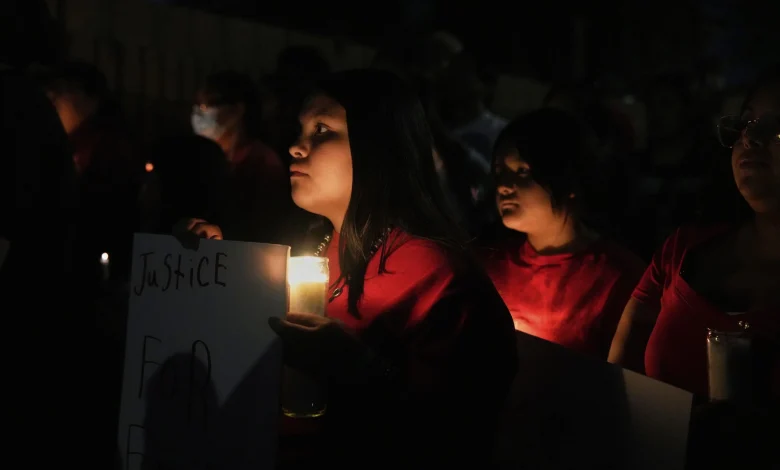Turquoise Alert used once since July launch despite hundreds missing in Arizona

Since launching in July, Arizona’s Turquoise Alert system — to aid in finding missing people — has been used once, despite 275 children and three adults reported missing over the last three months, an Arizona Luminaria analysis found.
Officials framed the alert as a solution to gaps in the system after 14-year-old Emily Pike disappeared for weeks before being found brutally murdered in February. But its inactivity in the face of hundreds of missing cases in recent months raises questions about the new system’s effectiveness.
The Arizona Department of Public Safety’s missing children database as of Oct. 24 showed 275 children under age 18 were reported missing since July 10, when the alert officially started. A spokesperson for DPS, which manages the state’s alert systems, did not immediately respond to emailed questions from Arizona Luminaria about the Turquoise Alert system and how its missing children database functions.
At least three other adults under age 65 also went missing during the same time frame, the National Missing and Unidentified Persons System database showed on Oct. 24. However, that database is voluntary, and there is no standardized system for tracking missing adults in Arizona.
All 278 of those people reported missing in Arizona over the last few months met the age threshold for a Turquoise Alert.
But to trigger the alert, the investigating agency: Must determine the missing person is in danger, or the circumstances of the disappearance are suspicious, and have exhausted all of its resources. It’s unclear whether any of those 278 cases met the criteria.
The Turquoise Alert was issued on July 23 for a 6-year-old girl from Hawaii after authorities said the girl’s mother fled the state with her. She was found safe by the Cottonwood Police Department within an hour of the alert notification.
The alert, created under House Bill 2281, can be initiated at the request of an investigating agency. DPS then reviews the case to determine if it qualifies for a statewide notification. It’s unknown how many Turquoise Alert requests have been submitted or if any were denied by DPS for not meeting the criteria.
The Turquoise Alert system was created to bridge a gap in Arizona’s existing alert systems by covering missing people under the age of 65 who don’t qualify for Amber or Silver alerts. Arizona’s Amber Alerts apply to abducted children under 18. Silver Alerts are issued for missing seniors or adults with cognitive impairments.
“No one looked for her”
Emily Pike, a member of the San Carlos Apache Tribe, went missing from a group home in Mesa earlier this year. She was labeled a runaway and her disappearance was not widely known when Rep. Teresa Martinez, a Republican from Casa Grande, introduced House Bill 2281 in January.
Still, after Emily was found brutally murdered weeks later near Globe, her story was used to rally support for the legislation. It was also renamed “Emily’s Law” in her honor.
“When we announced this bill, it was in January, we had no idea that Emily Pike had gone missing,” Martinez previously said about the measure. “By the time it came over to the Senate, we had realized that not only had she gone missing, she had been missing for 30 days, and no one bothered to look for her.
“Had this law been in place, an alert would’ve gone out to look for this little girl. It breaks my heart that we the state of Arizona didn’t go looking for this little girl. No one looked for her,” she continued, her voice cracking. “We cannot let children go missing without somebody being alerted. I think my great niece who is a member of the Gila River Indian tribe, if she went missing, I would turn this world upside down looking for her. We need to do that for every single one of our children and every single one of our loved ones.”
However, officials previously confirmed Emily’s case would not have qualified for a Turquoise Alert due to her being labeled a runaway and not considered endangered at the time she disappeared. It’s unclear if any of the children listed as missing since the alert’s launch are considered runaways.
“As far as runaway goes, in and of itself, a runaway isn’t necessarily a crime or a suspicious or unexplained circumstance,” Arizona DPS Captain Thomas Neve said during a ceremonial signing of law. “So if somebody decides to leave or go missing of their own volition … it wouldn’t necessarily qualify.”
“But again, if the circumstances are suspicious or unexplained, adding that to somebody who maybe ran away might actually, I would say, tip the scale to actually meeting that criteria,” he continued.
People go missing for a variety of reasons and sometimes for just a few hours. Authorities also say someone going missing is not a crime.
That fluidity makes it difficult to track disappearances in a consistent way, especially when reporting is often voluntary and classifications like runaway and endangered can vary across agencies.
Get Arizona Luminaria’s weekly email
System more inclusive, questions remain
Advocates, including Emily’s own Tribal Nation and family, say the runaway label shouldn’t be used for any missing child because it takes away the urgency from cases.
“I hear two words, ‘runaway and missing.’ Two little words that make a big difference on whether an investigation is done or whether they just sweep it under the rug,” Emily’s uncle, Allred Pike Jr., said at the ceremonial signing in May. “Something that’s named after her wouldn’t have made a difference if she was still here, that’s something that we need to take a look at.”
A growing number of criminal justice experts also argue any missing child under 18 should immediately be considered endangered to spur calls for the wider public’s help — before it’s too late.
Indigenous children in particular go missing “at a disproportionate rate to their representation in the overall U.S. population of children,” according to a 2023 congressional report. Since the Turquoise Alert was implemented on July 10, children identified as “Indian” were reported missing in Arizona, according to the DPS database.
The legislation establishing the Turquoise Alert system was initially introduced to focus exclusively on missing Indigenous people, but was later amended to include non-Indigenous endangered people between 18 and 64, which would’ve excluded Emily since she was a minor.
It was amended again in April to include all minors after Arizona Luminaria reported the age restriction would’ve made Emily’s case ineligible based on her age alone.
While the changes have made the alert system more inclusive, it also shifted attention away from the alert’s initial purpose: To address the disproportionately high rates of violence Indigenous communities face — an issue long overlooked by government and criminal justice systems across the state and nation.
Arizona is home to 22 federally recognized Tribal Nations, and was identified in a 2018 study as having the third-highest number of Indigenous women and girls going missing or being murdered in the country.
In 2020, a legislative study found that 160 Indigenous women and girls were murdered in Arizona between 1976 and 2018 — a total that steadily increased in those 40 years. Additionally, the National Missing and Unidentified Persons System showed just over 90 Native Americans were reported missing in Arizona since 1956, the database showed as of Oct. 23.
Arizona Luminaria recently launched an MMIP database, where just under 100 women and girls who are missing or were murdered are reflected so far. That data has shown that women ages 19 to 46 accounted for about 70% of all the cases.
Related
Republish This Story
Republish our articles for free, online or in print.


![2025 Jiangxi Open: Blinkova [95th] vs. Bondar [74th] Prediction, Odds and Match Preview](https://cdn1.emegypt.net/wp-content/uploads/2025/10/2025-Jiangxi-Open-Blinkova-95th-vs-Bondar-74th-Prediction-Odds-390x220.webp)


